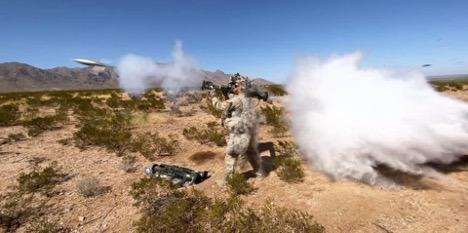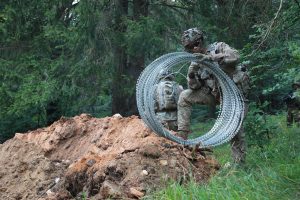The Mechanized Infantry Team Concept

In 2018, I attended the Maneuver Captains Career Course (MCCC) as an infantry officer who had served solely in airborne units. Midway through the course, I anxiously opened an email notifying me that a Request for Orders (RFO) had been generated. During the early days of MCCC, I became aware of a new initiative spearheaded by the Army’s Human Resources Command (HRC) regarding Infantry officers. To ensure Infantry officers were eclectically developed, the Army was pushing a “vehicular imperative” that placed officers with primarily a light or airborne background into Stryker or Bradley formations. When I opened my RFO, my initial anxiety quickly gave way to dread. I received orders to the 1st Armored Division at Ft. Bliss, TX, which meant I would command a mechanized infantry company. At the time I read the email, I had never even seen a Bradley, much less understood its capabilities. What I did know, however, was that the learning curve I would soon face would be steep.
Having now completed my command time, I feel compelled to share some thoughts and lessons learned. Commanding such a formation was challenging, requiring constant balancing between crew lethality and dismounted proficiency. Additionally, the organizational cultural change was a stark departure from what I had previously experienced. For example, maintenance was now a critical focus and was something that extended beyond my M4 carbine. I also found myself having to place a special emphasis on crew stability to ensure my Infantry Fighting Vehicles (IFVs) were able to participate in training with qualified crews who knew how to safely maneuver them. Adjusting to commanding a company team added yet another layer of complexity.
The following sections expand on these peculiarities and challenges. Although this primer is not intended to provide an exhaustive account, I hope the insights shared here will, at the very least, help others who find themselves in a similar position.
The Company Team
At the onset of our National Training Center (NTC) train-up, my Battalion Commander informed me and an armor company commander that our two companies would be configured as company teams both during our train-up and while at NTC. The notification prompted me to turn to doctrine since I, nor my First Sergeant, had ever been a part of such a configuration.
ATP 3-90.1 states, “The company team is task-organized with mechanized Infantry and tank platoons based upon missions. Its effectiveness increases through the synergy of combined arms including tanks, Bradley fighting vehicles (BFV), Infantry, engineers, and support elements.” Typically, an armor company team consists of two tank platoons and one mechanized infantry platoon, while a mechanized Infantry company team consists of two mechanized Infantry platoons and one tank platoon. Effective application of the company team, according to ATP 3-90.1, as a combined arms force can capitalize on the strengths of the unit’s elements while minimizing its respective limitations.
Acknowledging this, I prioritized building a habitual relationship with the same tank platoon that was identified to be attached to my company. I reasoned this would allow us to build cohesion and be more effective in the long term. My Battalion Commander agreed, and every time he configured us into company teams, I received the same tank platoon.
Once a tank platoon was identified to be attached to my company, I tasked that platoon’s leadership to give my infantry soldiers a capabilities brief so they better understood the M1A2 Abrams platform. The discussion eventually veered to brainstorming TTPs that aimed to maximize each vehicle’s strengths while mitigating limitations. The conversation not only facilitated great ideas, but it created a buy-in effect from across the organization that was beneficial in establishing a united front.
Another integral aspect of the integration process my unit established was to identify at least one platform-specific mechanic to be a part of the team package as well. Doing this provided the gaining unit with the mechanical expertise needed to help identify and validate faults on the pacing vehicles that were attached with a maintainer from another Company’s FMT who knew the intricacies of those specific vehicles in the attached platoon.
My Battalion Commander’s focus on early integration during our NTC train-up proved critical. By the time we arrived at Fort Irwin, my armor platoon leader and platoon sergeant were accustomed to my command style, knew what my expectations were, and felt comfortable cross-talking with their peers across the company team. Delaying the establishment of this relationship would have hindered rapport and possibly degrade our effectiveness, especially early on during our NTC rotation.
I want to emphasize the following: one of the first things I admitted to my armor platoon leader and platoon sergeant was my lack of familiarity with tanks. I stressed that if we were going to be successful, I expected each of them to be ambassadors of their platform. This meant that I expected (and needed) them to speak up. By empowering my armor platoon leadership from the outset, I laid the foundation for them to be comfortable making tactical recommendations, requesting specific logistical requirements, and foster a sense of inclusion within the team.
Fighting the Mechanized Infantry Company Team
For the purposes of this section, I will focus briefly on specific challenges I faced during my NTC rotation (21-10) and how I employed my company team. For those who want a more in-depth reading, I recommend turning to ATP 3-90.1 to begin your studies.
The Enemy AT Threat
From the beginning of our NTC train-up, my guiding philosophy was to leverage the lethality of my tanks while minimizing the AT threat with my dismounts. This required a level of coordination among multiple elements (tanks, IFVs, dismounts, organic ISR) beyond what I had previously experienced.
Because of this focus, I prioritized leading with my dismounts whenever possible, especially across tough terrain where I anticipated an AT threat. While tank and IFV optics are highly effective, dismounted troops excel at clearing micro terrain or mountainous areas—terrain that enemy dismounted AT teams often exploit. This integration allowed me to leverage my Team’s strengths while mitigating risks. In my view, enemy dismounts armed with AT weapon systems posed one of the greatest threats to my formation. This made such integration key to increasing my company team’s survivability.
At the core of this integrative effort is the defile drill. Admittedly, the most difficult aspect of the defile drill is the patience required to successfully conduct it. However, the return on the time invested is in the drill’s ability to preserve your combat power before fully exposing your combat platforms.
The Defile
Mechanized infantry and armor company commanders should read CPT John W. Miller III’s article titled, “Clearing the Defile: A Doctrinal Discussion” which appears in the November-December 1994 edition of Armor Magazine. In his piece, CPT Miller provides an in-depth analysis of the defile and expounds on its importance. It is critical to emphasize that conducting a defile requires the commitment and tactical patience to synchronize across multiple fronts simultaneously. Because of this, communication is critical, especially between dismounts and their vehicular crews. In the absence of such a criticality, ground sensors would be unable to relay information, rendering them ineffective and leaving them unsupported. Ultimately, the defile is designed to minimize contact with the enemy by using the smallest element possible while developing the situation as it unfolds.
To conduct a defile, my first step was always to establish a Vehicle Drop Off (VDO) point either outside the enemy’s furthest Maximum Engage Line that I templated or behind adequate cover. This allowed my dismounts the time needed to assemble and orient themselves before maneuvering. Once set, my dismounts would clear terrain by phase line, triggering vehicular movement up to a previously cleared area. The drill created a slinky effect: infantry leads the way while vehicles remain arrayed in a tactical formation scanning their sectors. As dismounts cleared up to a phase line, vehicles then maneuvered forward up to the previously cleared area while dismounts continued clearing forward.
For greater coverage clearing complex terrain, I recommend employing your Raven to scan forward of your dismounts to help identify enemy positions. Many company commanders either neglect to employ their organic UAS or lack trained operators. To avoid this, ensure you deliberately set the conditions during your train-up to be able to have the right personnel trained on the platform. One of my primary goals during command was to be able to use all my organic capabilities. By managing your personnel effectively, you can achieve the same.
Logistical Considerations
One of the biggest hurdles I faced early on in commanding a company team was understanding the significant logistical demands of keeping tanks operational. This challenge became apparent as I realized that tanks consume far more fuel and POL than my IFVs. Because of this, I made sure my company executive officer worked closely with our tank platoon leadership to meet their unique logistical requirements.
However, the responsibility was not entirely on my executive officer. My First Sergeant and the company’s attached 91A mechanic played critical roles as well. Regular updates to the company’s Equipment Status Report (ESR) relied on insights from each of these key stakeholders. Once we got a handle on what was needed the most frequently, we were able to anticipate logistical requests. This proactive approach allowed our tanks to maintain a sustained impact on our operations.
I highly recommend that, in conjunction with the one-for-one swap of at least one 91A, you work with your FMT to acquire commonly needed tank parts for anticipated repairs. Pre-stage these parts in your contact truck to be able to immediately repair common low-level faults as close to the FLOT as possible without having to make such routine repairs at your battalion’s unit maintenance control point.
The same proactive approach was essential for managing petroleum, oil, and lubricants (POL), such as fire-resistant hydraulic fluid (FRH). Keeping a forward supply of POL with the company team proved critical, given how much our tanks consumed. Pre-staging lubricants and oils with the Company enabled us to maintain vehicle readiness and keep operations running smoothly.
In this type of formation, your lethality is directly correlated to the readiness of your vehicles. Prioritize maintenance, especially during field exercises, to ensure your operational effectiveness remains high.
Final Thoughts
For Infantry Officers assigned to an Armored Brigade Combat Team without prior experience in such a formation, I highly recommend attending the Bradley Leader Course and the Maneuver Leaders Maintenance Course at Fort Moore, GA. These courses provide a solid foundation in the primary platform you will command and introduce you to the maintenance ecosystem you will navigate. Additionally, serving as the Battalion Maintenance Officer can be invaluable preparation. If the opportunity arises, volunteer for this role, as it will teach you to manage a maintenance program effectively.
Commanding a mechanized infantry company was a challenging yet rewarding experience. The steep learning curve, combined with a maintenance culture that was unfamiliar to me, presented obstacles that required adaptability and acclimation to a different culture. While this type of formation is vastly different from what I experienced, I assure you that the professional and personal developmental opportunities it provides are worth the effort. For me, commanding a mechanized company team was a fulfilling experience, and I trust it will be for you as well.
Pat Serrato is an Infantry Officer currently commanding Cobra Company, 4-70th AR, 1st Armored Brigade Combat Team, 1st Armored Division. Pat has previously served as a Platoon Leader and in various staff positions within both 3-509th PIR, 4-25th in Joint Base Elmendorf-Richardson, Alaska, and in 3/75th Ranger Regiment in Fort Benning, Georgia. Pat is a GRADSO recipient whose next assignment will be as a graduate student at The Johns Hopkins School of Advanced International Studies to pursue a Masters in International Public Policy.
Related Posts

4 Essential Behaviors for Building Trust
Sincerity. Reliability. Competence. Care. No matter your role as a company-grade officer, trust is foundational to a team’s success. Trust connects a leader’s intent to …

Going Off Script, But Staying on Track: A Career Guide for Junior Leaders
Intro I walked into LTC Tomi King’s office as a new 2LT in his formation. We discussed all the normal talking points in that initial counseling – family, where I …

Fighting as an Enabler Leader
(U.S. Army Photo by Cpl. Tomarius Roberts, courtesy of DVIDS)Enablers provide capabilities to commanders that they either do not have on their own or do not have in sufficient quantity …
